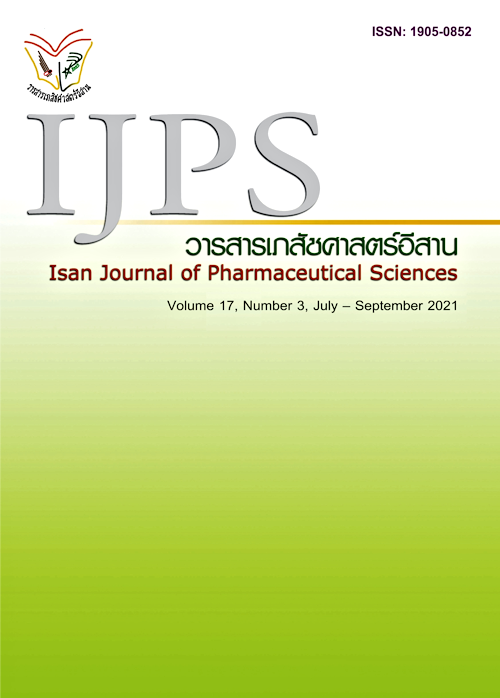Analysis of Alcohol Content in Alcohol-based Hand Sanitizer Product from Khon Kaen Province
Main Article Content
Abstract
Due to the current situation regarding the COVID-19 outbreak, it is important to reduce the chances of being infected or spreading COVID-19. The most effective concentration of alcohol in the disinfectants containing alcohol and water is more than 70 %(v/v). Objectives: To develop the determination of alcohol content in alcohol-based hand sanitizer products. To study the reliability of the analytical method for evaluation of the efficacy of alcohol-based hand sanitizer product. Methodology: Characterization of the physical appearance of alcohol-based hand sanitizer and raw material from community hospitals and institution in Khon Kaen provinces which were collected by the Consumer Protection Department, Khon Kaen Provincial Health Office. The proper analytical method was developed and studied about the linearity. Then the alcohol content in alcohol-based hand sanitizer products and raw materials were determined by using Gas chromatography method. Results: The linear calibration curve of standard ethyl alcohol in concentration ranges of 50 – 100 %(v/v) presented the linear equation of y = 0.0141X – 0.1023 and the correlation coefficient (r2) = 0.9994 (n = 3). For standard isopropanol alcohol solution, the standard curved was investigated in concentration ranges of 40 – 100 %(v/v). In these concentration ranges, the linear equation of isopropyl alcohol is y = 0.0137X – 0.0607 (r2 = 0.9995, n = 3). The average alcohol content in alcohol-based hand sanitizer products and raw materials were 73.8 ± 4.9 and 83.0 ± 11.5 %(v/v), respectively. Only one sample in 21 raw materials had the concentration of ethyl alcohol less than 50 %(v/v). Conclusion: The studies were found that all of the alcohol-based hand sanitizer products from community hospitals (8 samples) and institution (1 sample) in Khon Kaen province had the effective concentration of alcohol as disinfectants (not less than 70%(v/v)). For the raw materials, the only one in all samples had the concentration of ethyl alcohol under the legal limit. The results showed that all of alcohol-based hand sanitizer products from community hospitals and institution in Khon Kaen province provided the alcohol content within the effective concentration range. The application of the alcohol analytical method measured in alcohol-based hand sanitizer products can enhance consumers to access to the effective alcohol-based hand sanitizer product for prevention of COVID-19.
Article Details
In the case that some parts are used by others The author must Confirm that obtaining permission to use some of the original authors. And must attach evidence That the permission has been included
References
Backer J, Klinkenberg D, Wallinga J. Incubation period of 2019 novel coronavirus (2019-nCoV) infections among travellers from Wuhan, China, 20–28 January 2020. Euro Surveill 2020; 25(5): 1-6.
Daodee S, Wangboonskul J, Jarukamjorn. Quantitative and qualitative determination of alco-hols in stomachica and carminative mixture by gas chromatographic method with mass spectrometry. KKU Research J 1999; 4(2).
Dettmer-Wilde K, Engewald W. Practical Gas Chromatography: A Comprehensive Reference. Berlin: Springer-Verlag; 2014: 3-11.
Doremalen N, Morris D, Holbrook M, et al. Aerosol and surface stability of HCoV-19 (SARS-CoV-2) compared to SARS-CoV-1. N Engl J Med 2020; 382(16): 1-4.
Hemmati F, Saedi S, Hemmati-Dinarvand M, et al. Mysterious Virus: A Review on Behavior and Treatment Approaches of the Novel Coronavirus, 2019-nCoV. Arch Med Res 2020; 51(5): 375-383.
ICH harmonized tripartite guideline validation of analytical procedures text and methodology: Q2(R1). 2005.
Luangkriangkrai S and Inprasit C. Determination of ethanol in fermented media by head space - the internal standard method in gas chromatography. Proceeding of the 8th National Kasetsart University Kamphaeng Saen Conference (The 8th KU - KPS Conference), 2011 Dec 8-9; Bangkok, Thailand.
Neuman BW, Kiss G, Kunding AH, et al. A structural analysis of M protein in coronavirus assembly and morphology. J Struct Biol 2011; 174(1): 11-22.
Notification of the Ministry of Public Health (No.137) special part 54 B.E. 2563 (2020) Notified on 10th March B.E. 2563 (2020)
Ren SY, Wang WB, Hao YG, et al. Stability and infectivity of coronaviruses in inanimate environments. World J Clin Cases 2020; 8(8): 1391-1399.
Rowe R, Sheskey P, Quinn M. Handbook of Pharmaceutical Excipients 6th ed. Washington: Pharmaceutical Press and American Pharmacists Association; 2009. 17-19.
Rutala WA, Weber DJ, and Healthcare Infection Control Practices Advisory Committee. Guideline for Disinfection and Sterilization in Healthcare Facilities. Center for disease control and prevention 2008 (update May 2019).
World Health Organization. Clinical management of COVID-19: interim guidance 27 May 2020. Geneva: World Health Organization 2020.
World Health Organization. Modes of transmission of virus causing COVID-19: implications for IPC precaution recommendations 27 March 2020. Geneva: World Health Organization 2020 Available from: https://apps.who.int/iris/rest/bitstreams/1273262/retrieve.
Zhu N, Zhang D, Wang W, et al. A novel coronavirus from patients with pneumonia in China, 2019. N Engl J Med 2020; 382(8): 727-733.


